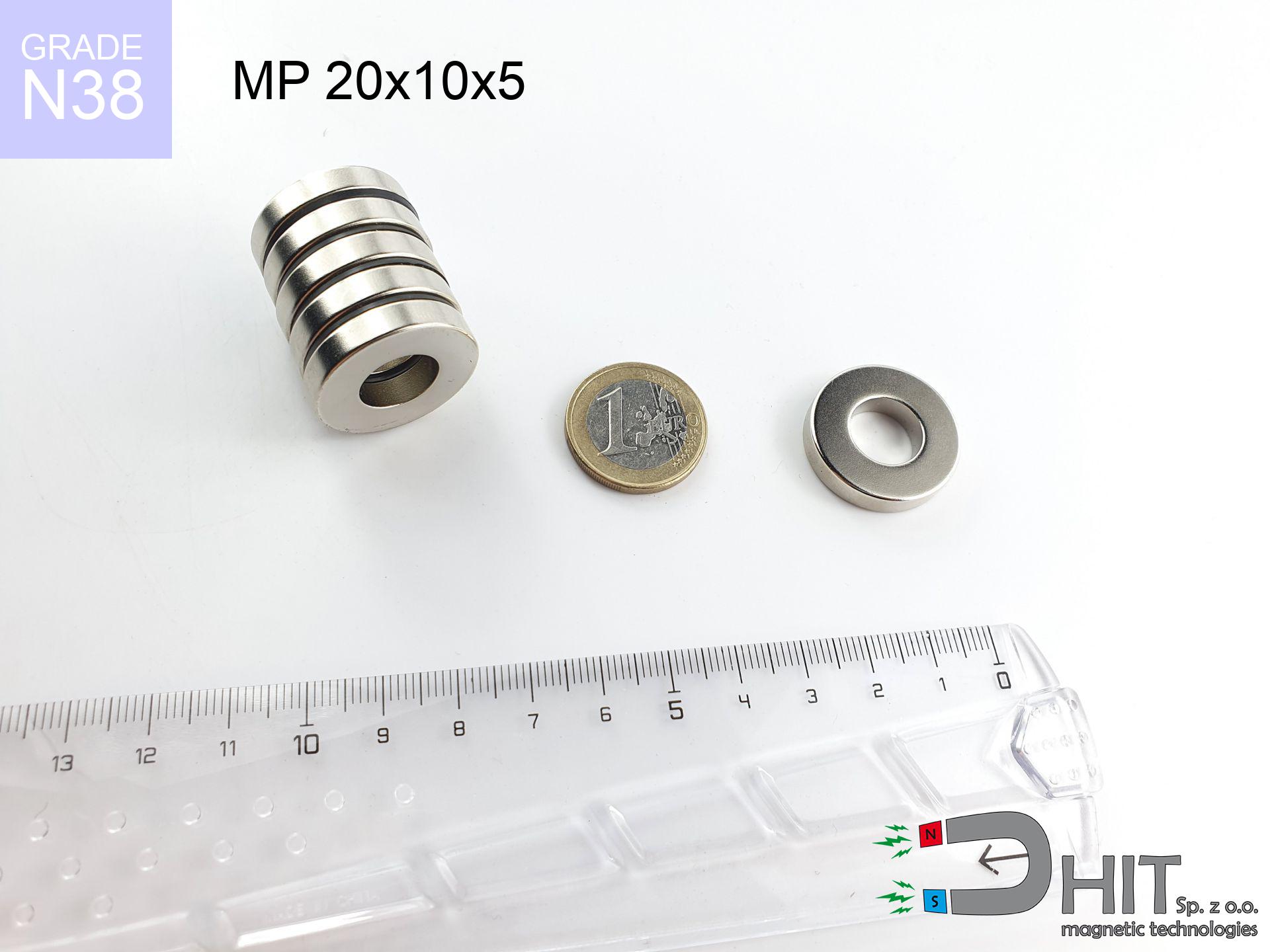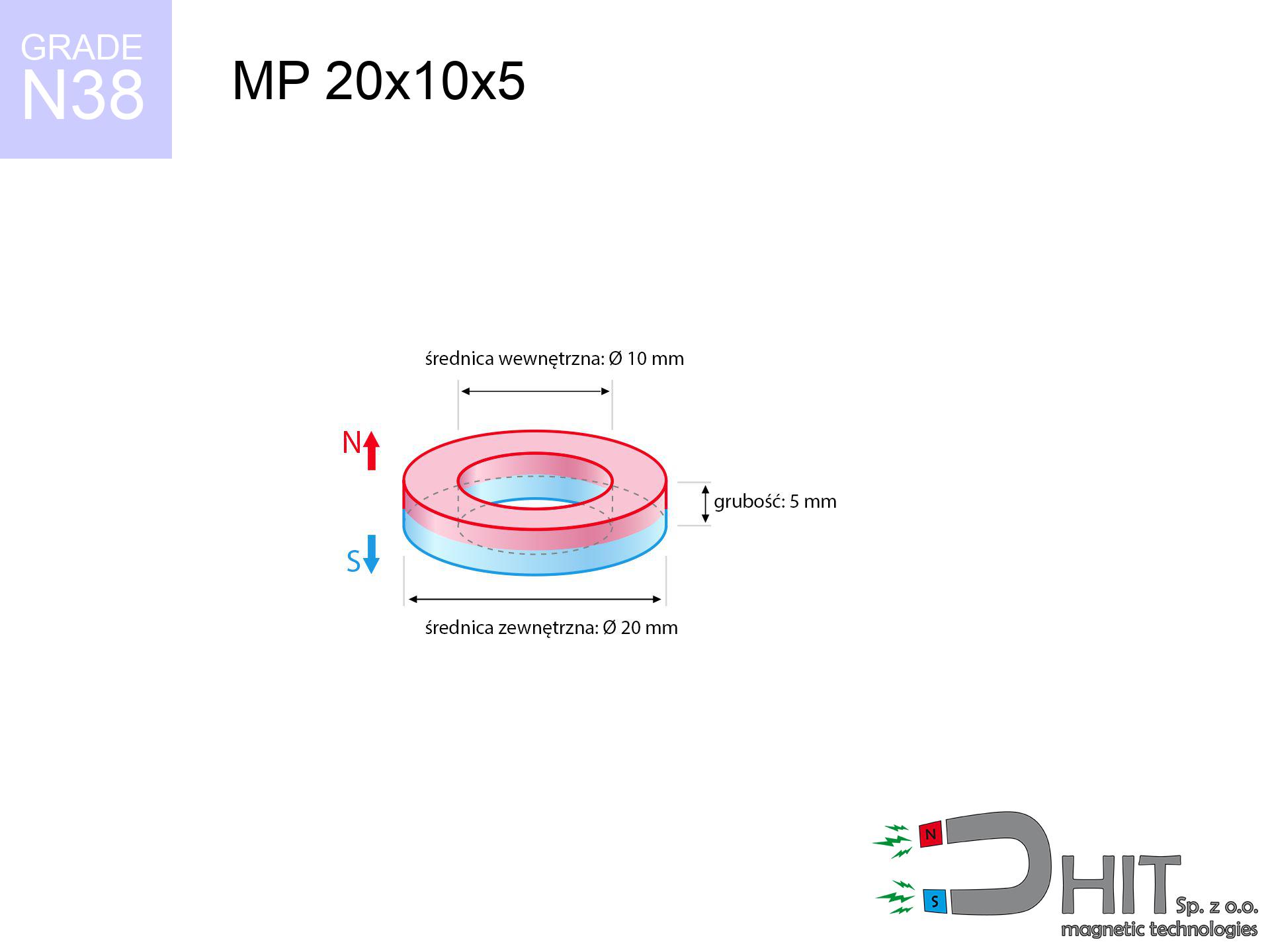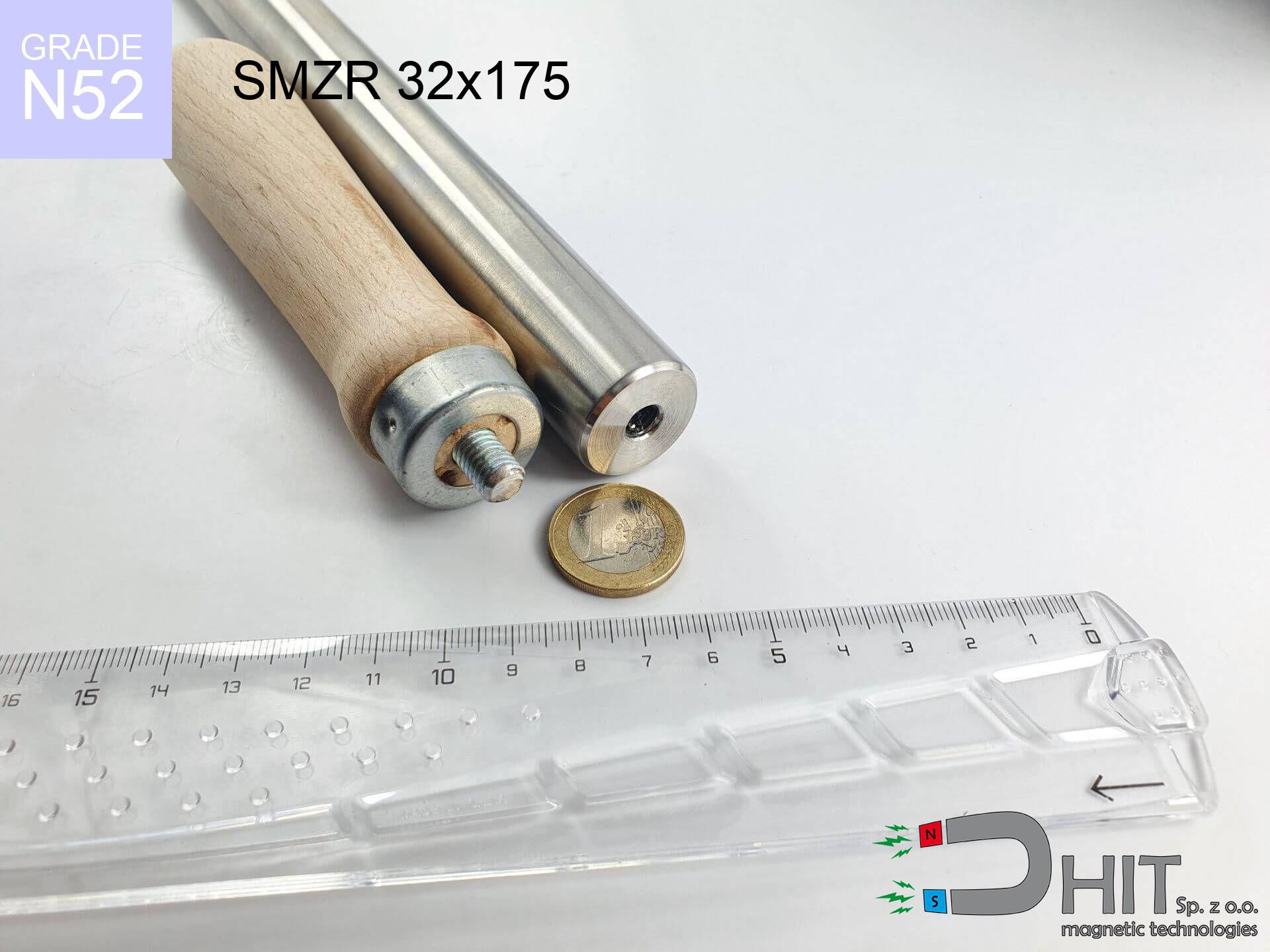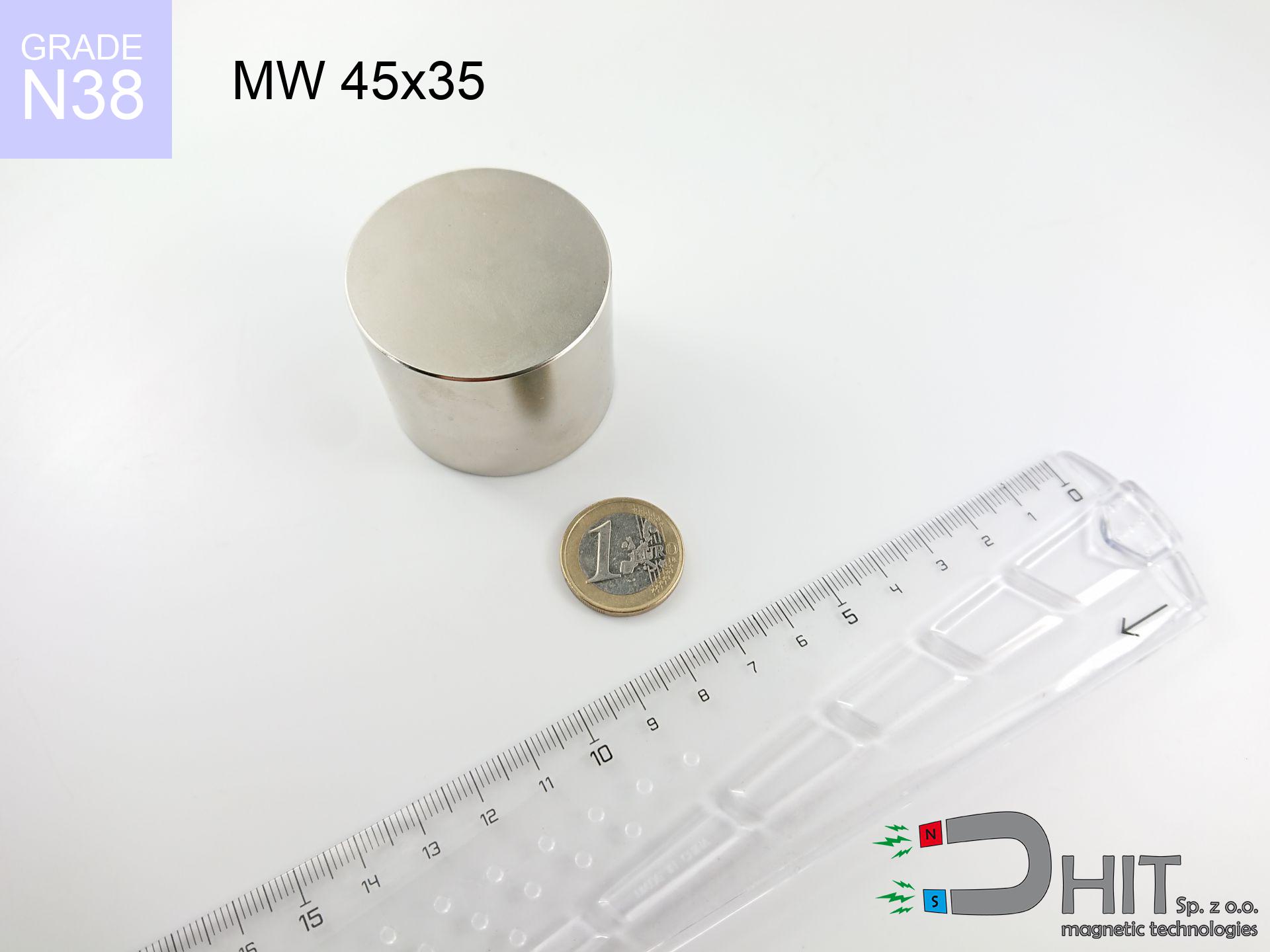MP 20x10x5 / N38 - ring magnet
ring magnet
Catalog no 030184
GTIN/EAN: 5906301812012
Diameter
20 mm [±0,1 mm]
internal diameter Ø
10 mm [±0,1 mm]
Height
5 mm [±0,1 mm]
Weight
8.84 g
Magnetization Direction
↑ axial
Load capacity
5.20 kg / 50.97 N
Magnetic Induction
277.16 mT / 2772 Gs
Coating
[NiCuNi] Nickel
4.50 ZŁ with VAT / pcs + price for transport
3.66 ZŁ net + 23% VAT / pcs
bulk discounts:
Need more?
Pick up the phone and ask
+48 22 499 98 98
or let us know using
contact form
our website.
Strength along with appearance of magnets can be estimated with our
magnetic calculator.
Same-day processing for orders placed before 14:00.
Detailed specification - MP 20x10x5 / N38 - ring magnet
Specification / characteristics - MP 20x10x5 / N38 - ring magnet
| properties | values |
|---|---|
| Cat. no. | 030184 |
| GTIN/EAN | 5906301812012 |
| Production/Distribution | Dhit sp. z o.o. |
| Country of origin | Poland / China / Germany |
| Customs code | 85059029 |
| Diameter | 20 mm [±0,1 mm] |
| internal diameter Ø | 10 mm [±0,1 mm] |
| Height | 5 mm [±0,1 mm] |
| Weight | 8.84 g |
| Magnetization Direction | ↑ axial |
| Load capacity ~ ? | 5.20 kg / 50.97 N |
| Magnetic Induction ~ ? | 277.16 mT / 2772 Gs |
| Coating | [NiCuNi] Nickel |
| Manufacturing Tolerance | ±0.1 mm |
Magnetic properties of material N38
| properties | values | units |
|---|---|---|
| remenance Br [min. - max.] ? | 12.2-12.6 | kGs |
| remenance Br [min. - max.] ? | 1220-1260 | mT |
| coercivity bHc ? | 10.8-11.5 | kOe |
| coercivity bHc ? | 860-915 | kA/m |
| actual internal force iHc | ≥ 12 | kOe |
| actual internal force iHc | ≥ 955 | kA/m |
| energy density [min. - max.] ? | 36-38 | BH max MGOe |
| energy density [min. - max.] ? | 287-303 | BH max KJ/m |
| max. temperature ? | ≤ 80 | °C |
Physical properties of sintered neodymium magnets Nd2Fe14B at 20°C
| properties | values | units |
|---|---|---|
| Vickers hardness | ≥550 | Hv |
| Density | ≥7.4 | g/cm3 |
| Curie Temperature TC | 312 - 380 | °C |
| Curie Temperature TF | 593 - 716 | °F |
| Specific resistance | 150 | μΩ⋅cm |
| Bending strength | 250 | MPa |
| Compressive strength | 1000~1100 | MPa |
| Thermal expansion parallel (∥) to orientation (M) | (3-4) x 10-6 | °C-1 |
| Thermal expansion perpendicular (⊥) to orientation (M) | -(1-3) x 10-6 | °C-1 |
| Young's modulus | 1.7 x 104 | kg/mm² |
Technical modeling of the magnet - technical parameters
The following data represent the result of a mathematical calculation. Results were calculated on models for the class Nd2Fe14B. Operational performance may differ. Use these calculations as a reference point when designing systems.
Table 1: Static pull force (pull vs distance) - interaction chart
MP 20x10x5 / N38
| Distance (mm) | Induction (Gauss) / mT | Pull Force (kg/lbs/g/N) | Risk Status |
|---|---|---|---|
| 0 mm |
5917 Gs
591.7 mT
|
5.20 kg / 11.46 pounds
5200.0 g / 51.0 N
|
medium risk |
| 1 mm |
5321 Gs
532.1 mT
|
4.21 kg / 9.27 pounds
4205.9 g / 41.3 N
|
medium risk |
| 2 mm |
4736 Gs
473.6 mT
|
3.33 kg / 7.35 pounds
3332.2 g / 32.7 N
|
medium risk |
| 3 mm |
4184 Gs
418.4 mT
|
2.60 kg / 5.73 pounds
2600.0 g / 25.5 N
|
medium risk |
| 5 mm |
3216 Gs
321.6 mT
|
1.54 kg / 3.39 pounds
1536.2 g / 15.1 N
|
weak grip |
| 10 mm |
1650 Gs
165.0 mT
|
0.40 kg / 0.89 pounds
404.2 g / 4.0 N
|
weak grip |
| 15 mm |
907 Gs
90.7 mT
|
0.12 kg / 0.27 pounds
122.3 g / 1.2 N
|
weak grip |
| 20 mm |
544 Gs
54.4 mT
|
0.04 kg / 0.10 pounds
44.0 g / 0.4 N
|
weak grip |
| 30 mm |
240 Gs
24.0 mT
|
0.01 kg / 0.02 pounds
8.5 g / 0.1 N
|
weak grip |
| 50 mm |
75 Gs
7.5 mT
|
0.00 kg / 0.00 pounds
0.8 g / 0.0 N
|
weak grip |
Table 2: Sliding force (wall)
MP 20x10x5 / N38
| Distance (mm) | Friction coefficient | Pull Force (kg/lbs/g/N) |
|---|---|---|
| 0 mm | Stal (~0.2) |
1.04 kg / 2.29 pounds
1040.0 g / 10.2 N
|
| 1 mm | Stal (~0.2) |
0.84 kg / 1.86 pounds
842.0 g / 8.3 N
|
| 2 mm | Stal (~0.2) |
0.67 kg / 1.47 pounds
666.0 g / 6.5 N
|
| 3 mm | Stal (~0.2) |
0.52 kg / 1.15 pounds
520.0 g / 5.1 N
|
| 5 mm | Stal (~0.2) |
0.31 kg / 0.68 pounds
308.0 g / 3.0 N
|
| 10 mm | Stal (~0.2) |
0.08 kg / 0.18 pounds
80.0 g / 0.8 N
|
| 15 mm | Stal (~0.2) |
0.02 kg / 0.05 pounds
24.0 g / 0.2 N
|
| 20 mm | Stal (~0.2) |
0.01 kg / 0.02 pounds
8.0 g / 0.1 N
|
| 30 mm | Stal (~0.2) |
0.00 kg / 0.00 pounds
2.0 g / 0.0 N
|
| 50 mm | Stal (~0.2) |
0.00 kg / 0.00 pounds
0.0 g / 0.0 N
|
Table 3: Wall mounting (sliding) - behavior on slippery surfaces
MP 20x10x5 / N38
| Surface type | Friction coefficient / % Mocy | Max load (kg/lbs/g/N) |
|---|---|---|
| Raw steel |
µ = 0.3
30% Nominalnej Siły
|
1.56 kg / 3.44 pounds
1560.0 g / 15.3 N
|
| Painted steel (standard) |
µ = 0.2
20% Nominalnej Siły
|
1.04 kg / 2.29 pounds
1040.0 g / 10.2 N
|
| Oily/slippery steel |
µ = 0.1
10% Nominalnej Siły
|
0.52 kg / 1.15 pounds
520.0 g / 5.1 N
|
| Magnet with anti-slip rubber |
µ = 0.5
50% Nominalnej Siły
|
2.60 kg / 5.73 pounds
2600.0 g / 25.5 N
|
Table 4: Steel thickness (saturation) - sheet metal selection
MP 20x10x5 / N38
| Steel thickness (mm) | % power | Real pull force (kg/lbs/g/N) |
|---|---|---|
| 0.5 mm |
|
0.52 kg / 1.15 pounds
520.0 g / 5.1 N
|
| 1 mm |
|
1.30 kg / 2.87 pounds
1300.0 g / 12.8 N
|
| 2 mm |
|
2.60 kg / 5.73 pounds
2600.0 g / 25.5 N
|
| 3 mm |
|
3.90 kg / 8.60 pounds
3900.0 g / 38.3 N
|
| 5 mm |
|
5.20 kg / 11.46 pounds
5200.0 g / 51.0 N
|
| 10 mm |
|
5.20 kg / 11.46 pounds
5200.0 g / 51.0 N
|
| 11 mm |
|
5.20 kg / 11.46 pounds
5200.0 g / 51.0 N
|
| 12 mm |
|
5.20 kg / 11.46 pounds
5200.0 g / 51.0 N
|
Table 5: Thermal resistance (material behavior) - power drop
MP 20x10x5 / N38
| Ambient temp. (°C) | Power loss | Remaining pull (kg/lbs/g/N) | Status |
|---|---|---|---|
| 20 °C | 0.0% |
5.20 kg / 11.46 pounds
5200.0 g / 51.0 N
|
OK |
| 40 °C | -2.2% |
5.09 kg / 11.21 pounds
5085.6 g / 49.9 N
|
OK |
| 60 °C | -4.4% |
4.97 kg / 10.96 pounds
4971.2 g / 48.8 N
|
OK |
| 80 °C | -6.6% |
4.86 kg / 10.71 pounds
4856.8 g / 47.6 N
|
|
| 100 °C | -28.8% |
3.70 kg / 8.16 pounds
3702.4 g / 36.3 N
|
Table 6: Magnet-Magnet interaction (attraction) - field range
MP 20x10x5 / N38
| Gap (mm) | Attraction (kg/lbs) (N-S) | Lateral Force (kg/lbs/g/N) | Repulsion (kg/lbs) (N-N) |
|---|---|---|---|
| 0 mm |
54.03 kg / 119.11 pounds
6 121 Gs
|
8.10 kg / 17.87 pounds
8104 g / 79.5 N
|
N/A |
| 1 mm |
48.76 kg / 107.50 pounds
11 242 Gs
|
7.31 kg / 16.13 pounds
7314 g / 71.8 N
|
43.89 kg / 96.75 pounds
~0 Gs
|
| 2 mm |
43.70 kg / 96.34 pounds
10 642 Gs
|
6.55 kg / 14.45 pounds
6555 g / 64.3 N
|
39.33 kg / 86.71 pounds
~0 Gs
|
| 3 mm |
38.98 kg / 85.94 pounds
10 051 Gs
|
5.85 kg / 12.89 pounds
5847 g / 57.4 N
|
35.08 kg / 77.34 pounds
~0 Gs
|
| 5 mm |
30.63 kg / 67.54 pounds
8 910 Gs
|
4.60 kg / 10.13 pounds
4595 g / 45.1 N
|
27.57 kg / 60.78 pounds
~0 Gs
|
| 10 mm |
15.96 kg / 35.19 pounds
6 432 Gs
|
2.39 kg / 5.28 pounds
2394 g / 23.5 N
|
14.36 kg / 31.67 pounds
~0 Gs
|
| 20 mm |
4.20 kg / 9.26 pounds
3 299 Gs
|
0.63 kg / 1.39 pounds
630 g / 6.2 N
|
3.78 kg / 8.33 pounds
~0 Gs
|
| 50 mm |
0.19 kg / 0.42 pounds
702 Gs
|
0.03 kg / 0.06 pounds
29 g / 0.3 N
|
0.17 kg / 0.38 pounds
~0 Gs
|
| 60 mm |
0.09 kg / 0.20 pounds
480 Gs
|
0.01 kg / 0.03 pounds
13 g / 0.1 N
|
0.08 kg / 0.18 pounds
~0 Gs
|
| 70 mm |
0.05 kg / 0.10 pounds
342 Gs
|
0.01 kg / 0.01 pounds
7 g / 0.1 N
|
0.04 kg / 0.09 pounds
~0 Gs
|
| 80 mm |
0.02 kg / 0.05 pounds
253 Gs
|
0.00 kg / 0.01 pounds
4 g / 0.0 N
|
0.02 kg / 0.05 pounds
~0 Gs
|
| 90 mm |
0.01 kg / 0.03 pounds
193 Gs
|
0.00 kg / 0.00 pounds
2 g / 0.0 N
|
0.01 kg / 0.03 pounds
~0 Gs
|
| 100 mm |
0.01 kg / 0.02 pounds
150 Gs
|
0.00 kg / 0.00 pounds
1 g / 0.0 N
|
0.00 kg / 0.00 pounds
~0 Gs
|
Table 7: Hazards (implants) - warnings
MP 20x10x5 / N38
| Object / Device | Limit (Gauss) / mT | Safe distance |
|---|---|---|
| Pacemaker | 5 Gs (0.5 mT) | 14.5 cm |
| Hearing aid | 10 Gs (1.0 mT) | 11.5 cm |
| Timepiece | 20 Gs (2.0 mT) | 9.0 cm |
| Phone / Smartphone | 40 Gs (4.0 mT) | 6.5 cm |
| Remote | 50 Gs (5.0 mT) | 6.0 cm |
| Payment card | 400 Gs (40.0 mT) | 2.5 cm |
| HDD hard drive | 600 Gs (60.0 mT) | 2.0 cm |
Table 8: Impact energy (kinetic energy) - warning
MP 20x10x5 / N38
| Start from (mm) | Speed (km/h) | Energy (J) | Predicted outcome |
|---|---|---|---|
| 10 mm |
25.62 km/h
(7.12 m/s)
|
0.22 J | |
| 30 mm |
42.41 km/h
(11.78 m/s)
|
0.61 J | |
| 50 mm |
54.70 km/h
(15.19 m/s)
|
1.02 J | |
| 100 mm |
77.35 km/h
(21.49 m/s)
|
2.04 J |
Table 9: Coating parameters (durability)
MP 20x10x5 / N38
| Technical parameter | Value / Description |
|---|---|
| Coating type | [NiCuNi] Nickel |
| Layer structure | Nickel - Copper - Nickel |
| Layer thickness | 10-20 µm |
| Salt spray test (SST) ? | 24 h |
| Recommended environment | Indoors only (dry) |
Table 10: Construction data (Pc)
MP 20x10x5 / N38
| Parameter | Value | SI Unit / Description |
|---|---|---|
| Magnetic Flux | 16 116 Mx | 161.2 µWb |
| Pc Coefficient | 1.13 | High (Stable) |
Table 11: Hydrostatics and buoyancy
MP 20x10x5 / N38
| Environment | Effective steel pull | Effect |
|---|---|---|
| Air (land) | 5.20 kg | Standard |
| Water (riverbed) |
5.95 kg
(+0.75 kg buoyancy gain)
|
+14.5% |
1. Vertical hold
*Caution: On a vertical wall, the magnet retains only a fraction of its nominal pull.
2. Steel thickness impact
*Thin metal sheet (e.g. 0.5mm PC case) significantly limits the holding force.
3. Heat tolerance
*For standard magnets, the max working temp is 80°C.
4. Demagnetization curve and operating point (B-H)
chart generated for the permeance coefficient Pc (Permeance Coefficient) = 1.13
This simulation demonstrates the magnetic stability of the selected magnet under specific geometric conditions. The solid red line represents the demagnetization curve (material potential), while the dashed blue line is the load line based on the magnet's geometry. The Pc (Permeance Coefficient), also known as the load line slope, is a dimensionless value that describes the relationship between the magnet's shape and its magnetic stability. The intersection of these two lines (the black dot) is the operating point — it determines the actual magnetic flux density generated by the magnet in this specific configuration. A higher Pc value means the magnet is more 'slender' (tall relative to its area), resulting in a higher operating point and better resistance to irreversible demagnetization caused by external fields or temperature. A value of 0.42 is relatively low (typical for flat magnets), meaning the operating point is closer to the 'knee' of the curve — caution is advised when operating at temperatures near the maximum limit to avoid strength loss.
Material specification
| iron (Fe) | 64% – 68% |
| neodymium (Nd) | 29% – 32% |
| boron (B) | 1.1% – 1.2% |
| dysprosium (Dy) | 0.5% – 2.0% |
| coating (Ni-Cu-Ni) | < 0.05% |
Sustainability
| recyclability (EoL) | 100% |
| recycled raw materials | ~10% (pre-cons) |
| carbon footprint | low / zredukowany |
| waste code (EWC) | 16 02 16 |
Other products
Advantages and disadvantages of rare earth magnets.
Pros
- They have unchanged lifting capacity, and over around 10 years their performance decreases symbolically – ~1% (in testing),
- They feature excellent resistance to weakening of magnetic properties when exposed to opposing magnetic fields,
- By using a shiny coating of nickel, the element has an proper look,
- Neodymium magnets achieve maximum magnetic induction on a small surface, which allows for strong attraction,
- Made from properly selected components, these magnets show impressive resistance to high heat, enabling them to function (depending on their shape) at temperatures up to 230°C and above...
- Due to the ability of flexible shaping and adaptation to custom requirements, magnetic components can be produced in a wide range of forms and dimensions, which increases their versatility,
- Significant place in electronics industry – they are utilized in data components, electromotive mechanisms, medical devices, as well as complex engineering applications.
- Thanks to their power density, small magnets offer high operating force, with minimal size,
Disadvantages
- They are fragile upon too strong impacts. To avoid cracks, it is worth securing magnets in a protective case. Such protection not only shields the magnet but also improves its resistance to damage
- Neodymium magnets lose their force under the influence of heating. As soon as 80°C is exceeded, many of them start losing their power. Therefore, we recommend our special magnets marked [AH], which maintain durability even at temperatures up to 230°C
- Due to the susceptibility of magnets to corrosion in a humid environment, we recommend using waterproof magnets made of rubber, plastic or other material stable to moisture, when using outdoors
- Due to limitations in realizing threads and complicated forms in magnets, we recommend using a housing - magnetic holder.
- Possible danger resulting from small fragments of magnets are risky, in case of ingestion, which is particularly important in the context of child health protection. Furthermore, small elements of these products can complicate diagnosis medical when they are in the body.
- Due to complex production process, their price is higher than average,
Holding force characteristics
Best holding force of the magnet in ideal parameters – what affects it?
- on a plate made of mild steel, optimally conducting the magnetic field
- possessing a thickness of minimum 10 mm to avoid saturation
- with an polished contact surface
- with zero gap (no impurities)
- during detachment in a direction vertical to the plane
- at standard ambient temperature
Lifting capacity in real conditions – factors
- Clearance – the presence of foreign body (rust, tape, gap) interrupts the magnetic circuit, which lowers power steeply (even by 50% at 0.5 mm).
- Loading method – catalog parameter refers to detachment vertically. When slipping, the magnet holds much less (often approx. 20-30% of maximum force).
- Wall thickness – thin material does not allow full use of the magnet. Part of the magnetic field passes through the material instead of generating force.
- Material type – the best choice is pure iron steel. Cast iron may generate lower lifting capacity.
- Surface structure – the more even the surface, the larger the contact zone and stronger the hold. Unevenness acts like micro-gaps.
- Heat – NdFeB sinters have a sensitivity to temperature. At higher temperatures they lose power, and at low temperatures they can be stronger (up to a certain limit).
Lifting capacity was measured by applying a smooth steel plate of optimal thickness (min. 20 mm), under perpendicular detachment force, whereas under attempts to slide the magnet the holding force is lower. Additionally, even a slight gap between the magnet’s surface and the plate reduces the load capacity.
H&S for magnets
Operating temperature
Monitor thermal conditions. Heating the magnet to high heat will destroy its properties and pulling force.
Precision electronics
A strong magnetic field negatively affects the functioning of magnetometers in smartphones and navigation systems. Maintain magnets close to a smartphone to prevent breaking the sensors.
Immense force
Be careful. Rare earth magnets attract from a distance and snap with massive power, often faster than you can move away.
Sensitization to coating
Medical facts indicate that nickel (the usual finish) is a strong allergen. If you have an allergy, refrain from touching magnets with bare hands and choose encased magnets.
Fire warning
Combustion risk: Rare earth powder is highly flammable. Avoid machining magnets without safety gear as this may cause fire.
Adults only
Always store magnets away from children. Choking hazard is significant, and the consequences of magnets clamping inside the body are life-threatening.
Health Danger
Life threat: Strong magnets can deactivate heart devices and defibrillators. Stay away if you have medical devices.
Hand protection
Pinching hazard: The pulling power is so immense that it can cause blood blisters, crushing, and even bone fractures. Use thick gloves.
Fragile material
Despite the nickel coating, the material is delicate and cannot withstand shocks. Avoid impacts, as the magnet may shatter into hazardous fragments.
Electronic devices
Device Safety: Strong magnets can damage payment cards and sensitive devices (pacemakers, hearing aids, timepieces).





![AM ucho małe [M8] - magnetic accessories AM ucho małe [M8] - magnetic accessories](https://cdn3.dhit.pl/graphics/products/am-ucho-małe-m8-zud.jpg)
![BM 320x180x70 [4x M8] - magnetic beam BM 320x180x70 [4x M8] - magnetic beam](https://cdn3.dhit.pl/graphics/products/bm-320x180x70-4x-m8-rar.jpg)


